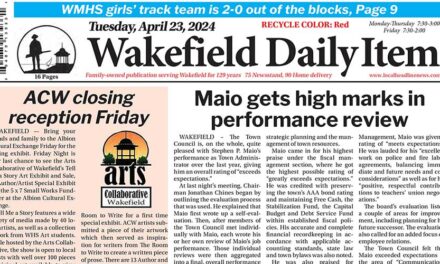Published in the July 30, 2015 edition
When the new World War II Monument was unveiled on Nov. 11, 2011, it was a proud moment for the entire community. The wood memorial that it replaced had suffered the ravages of time and could not be saved.
The old World War II Monument was the most pressing need. But the beautiful new granite monument that replaced it has also served to highlight the fact that other monuments on Veterans Memorial Common are also in need of attention. That focus has now shifted to the Civil War memorial, also known as the “Soldiers’ and Sailors’ Monument.”
The granite Soldiers’ and Sailors’ Monument towers over Veterans Memorial Common. An inscription on the column, just above the base of the monument reads, “Dedicated to the men of South Reading who gave their lives to keep the States United. 1861-1865.”
Around the base of the monument stand four life-size granite sculptures of servicemen. Atop the monument’s tall column stands a fifth soldier, embracing the flag of the Union.
The Soldiers’ and Sailors’ Monument was dedicated on June 17, 1902, at exercises that followed a grand parade. Then Governor Winthrop M. Crane was in attendance, according to William Eaton’s 1944 History of Wakefield. Congressman Samuel W. McCall delivered the oration. Eaton called the monument “an inspiration to all present and future generations, a constant public reminder that sacrifices had been made and should be, to maintain our country’s honor.”
But the oldest war memorial on the Common is now 113 years old. It has withstood ravages of time and the New England climate as well as could be expected. Now it needs help.
Wakefield Veterans Services Officer Alicia Reddin recently endeavored to find out what it would take to restore the stately memorial and reported back to the Board of Selectmen.
Vermont company Granite Corporation of Barre is one of only two firms in the United States with the capability of handling such a monumental restoration, Reddin told the selectmen. The other company is on the West Coast. Granite Corporation of Barre took a look at the monument and provided an estimate, detailing the damage to the monument.
The original jointing material has failed, allowing water, dust and dirt to wash into the joints between the granite pieces. The accumulated material holds moisture and has allowed small plants to grow within these spaces. The freeze and thaw cycles over many years have slowly caused the lower multi-piece granite courses to separate from each other.
The sculptures of the soldiers are also damaged and show evidence of past repair, according to the estimate. One sculpture is in such bad shape that it may need to be replaced.
The existing condition of the monument is not an immediate safety concern, the company says, but left unattended, the situation will worsen and cause failure to the foundation until it becomes unstable.
The best way to restore the monument, according to the company, would be to dismantle its sections and truck them to the company’s facility in Vermont.
Unfortunately, the restoration price will be many times more than the original $13,845 that it cost to build the monument in 1902. The Granite Corporation of Barre estimates that the work will cost $546,500 and take between eight to 12 months.
It cost about $425,000 to build the new World War II Monument, all of it raised through private donations.
As tough as it was to raise the money to replace the World War II monument, raising money for the restoration of the old Civil War monument is bound to be an even greater challenge.
Although they are fading away at a far too rapid pace, there are still World War II veterans alive today. Even those who have passed on left behind children, grandchildren and other living relatives who were willing to honor their memories with a donation.
No one living today remembers the Civil War, which ended 150 years ago. Few alive today have ever seen a Civil War veteran, most of whom were gone before the Second World War. To most of us, the Civil War is little more than a chapter in a history textbook.
Not only will the cost of restoring the Civil War Monument be greater than the cost of the new World War II monument, the living memory connections that drove donations to the World War II Monument won’t be there for the Civil War Soldiers’ and Sailors’ Monument.
But that may also be the best reason for finding a way to restore and preserve the town’s oldest war memorial. With living memory gone, a granite memorial is all that we have left to remind us and future generations of those brave men from Wakefield and beyond who died to preserve the Union.





